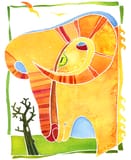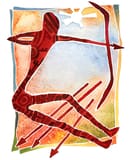The Winding Path of the Retrograde Cycle
When a planet goes retrograde or direct, it seems to stop moving and is "stationary." For weeks or months, before and after a planet's retrograde period, it is "in the (retrograde) Shadow." This 3-fold sequence defines the retrograde cycle.
Repeat yourself.
If you like it, do it again.
If you don't like it, do it again.~ Bruce Mau, An Incomplete Manifesto for Growth
Repeating Yourself
When any planet goes retrograde, it actually goes through the same span of the zodiac three times—forward, then backwards, then forwards again. When the planet changes direction, this is called a "station" or "being stationary" (motionless). The planet's progress through the zodiac slows down until it pauses (the station). Then it gradually starts moving again in the opposite direction.
If you were watching this in the sky over several days or weeks, you would see the planet slowly trace a loop in the sky. This is what the "astrologers of old" saw. You can just imagine them scratching their heads at these wacko lights in the heavens!
The Station ~ Turning on a Dime
The station of any planet is a time of intensified energy. The planet has stopped moving along the zodiacal path and seems to hover for up to several days before it resumes movement in the opposite direction. A planet's motion is slow enough before and after the station that its effects can be felt for several days (Mercury) or up to a couple of weeks (Uranus, Neptune and Pluto) before and after the station.
The effect is a bit like running your finger through a candle flame. If you do it quickly, you feel a little warmth but nothing painful. If you do it slowly it will feel hot and intense! When a planet is moving at its usual speed, its effects are relatively light, compared to when it is going slowly at the station, which is much more powerful and extreme.
The Retrograde Station (where the planet turns to go "backwards") can be frustrating because we are used to progressing forward in the circumstances, events and situations that have been developing during the pre-retrograde phase. Then suddenly we may hit a roadblock or a rough area of road, forcing us to slow down, proceed more cautiously, change direction, or stop what we're doing.
Alternatively, we may feel a sense of release and relief, because a stressful situation may have reached a resting place and given us some breathing time, during which we can regroup and figure out how to deal with it more effectively.
The Direct Station (where the planet turns to resume forward motion, at the end of the retrograde period) can also be frustrating, because we were just getting used to the retrograde energy and suddenly we have to change back to the other way again! However, this can be an important release point for the processes that have been evolving through the cycle so far.
It's not uncommon to reach a clear decision at the direct station about something you've been wrestling with or researching. Stress that has built up through the retrograde period might be released and let go. The shift in energy at the station can break a pattern of habitual or obsessive focus that you've become locked into during the retrograde.
The Shadow ~ Definition By Contrast
The area of the zodiac where the planet goes through this loopy retrograde cycle is called the Shadow. The actual sign and degrees are different for each retrograde cycle. That is, it's not like a planet goes retrograde in the same area of the zodiac every time; it's different for each retrograde cycle. The pre-retrograde Shadow and post-retrograde Shadow can be just as important and transformative as the actual retrograde period.
 During a planet's retrograde cycle, it typically looks like it follows a loop or Z-shape in the sky. You can see this in these examples: Mars in 2003, Mars in 2005, Venus 2000 and Venus in 2004. Also, see an animated gif showing 3 years of Saturn retrograde cycles.
During a planet's retrograde cycle, it typically looks like it follows a loop or Z-shape in the sky. You can see this in these examples: Mars in 2003, Mars in 2005, Venus 2000 and Venus in 2004. Also, see an animated gif showing 3 years of Saturn retrograde cycles.
When I refer in this article to the "retrograde cycle," it means all three phases: the pre-retrograde Shadow, the retrograde period, and the post-retrograde Shadow. The descriptions below apply to any planet, although the phases will be experienced a bit differently for each planet according to the themes, patterns and areas of life ruled by that planet.
Pre-Retrograde Shadow
This is the planet's first pass through the Shadow. In this phase, the planet is going in its usual "direct motion" (forward). This period typically brings up the issues that are on the cosmic agenda in your life for the coming retrograde cycle.
Events and situations that take place during this time will often unfold throughout the rest of the retrograde cycle. This might take the form of the same circumstances, or different ones which hinge on the same kind of underlying dynamics and issues. This phase begins when the planet passes the point of the zodiac where it will later make the direct station, and lasts until the retrograde station.
Retrograde Period
This is the second pass through the Shadow, when the planet appears to be going backwards in the sky. During this phase you might find you are reconsidering some actions or decisions you made during the first pass.
It is a time when you may have to confront the situations in your life that are not working well (which often correspond to the themes of that planet or the sign it's in). You might experience frustration, anger, fear, guilt or discouragement about having to take a detour away from your original or preferred path—or you might welcome this as a way of exploring new ideas and potentials.
Either way, the retrograde period is usually best travelled with some care and flexibility, being alert to the unexpected loose rocks and sinkholes that can cause you to trip and fall if you try to go over them too quickly. The retrograde period is typically a good time to pursue learning, research, reflection and re-evaluation. This phase starts with the retrograde station and lasts until the direct station.
Post-Retrograde Shadow
This is the third and final pass, when the planet is going forwards again after the direct station. During this phase you apply what you've learned during the retrograde period. In your exploration of new approaches to your issues and goals, it helps to reflect on what worked well and what didn't.
What do you know now that you didn't know before? How has this knowledge changed your perception of how to proceed? How can you change your direction (or your attitude) to take this new information into account? Or do you even need to change direction at all? Maybe you can resume the same course but with new knowledge and perceptions.
If you've been struggling with "inner demons" (uncomfortable feelings, impulses, fears, etc.), this phase is a good time to try out new ways to deal with them and express them. You often have opportunities to try out a new strategy to deal with the situations that trigger those feelings in you.
Sometimes those opportunities can seem more like you're "back at square one" and you're getting nowhere. But that doesn't mean you're backsliding or that you've failed! It IS a chance to try responding differently this time, based on what you've learned during the retrograde cycle.
You might still fall into the same "hole in the sidewalk," but you will have taken another step toward finding a way to avoid it. And you might actually change the outcome, or perhaps change your position within the situation.
Gather your courage, ground yourself in realism and clarity, and give it a try!
There's A Hole In My Sidewalk
(Autobiography in Five Chapters)By Portia Nelson
(1) I walk down the street. There is a deep hole in the sidewalk. I fall in. I am lost ... I am hopeless. It isn't my fault.It takes forever to find a way out.
(2) I walk down the same street. There is a deep hole in the sidewalk. I pretend I don't see it. I fall in again. I can't believe I'm in the same place. But it isn't my fault. It still takes a long time to get out.
(3) I walk down the same street. There is a deep hole in the sidewalk. I see it is there. I still fall in ... it's a habit. My eyes are open. I know where I am. It is my fault. I get out immediately.
(4) I walk down the same street. There is a deep hole in the sidewalk. I walk around it.
(5) I walk down another street.
© 2005 Wendy Guy, All rights reserved. Article and graphics may not be copied or used without the expressed permission of the author. Photo of winding road by Supot Phanna via 123rf.com














